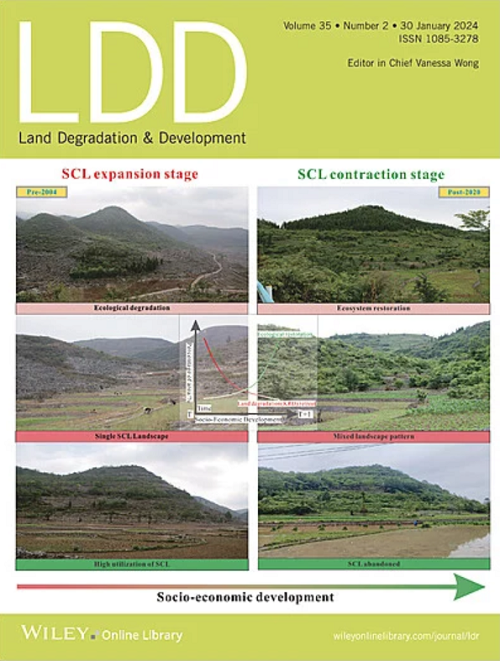地膜覆盖是黄土高原应对耕地流失、推动农业绿色发展的关键策略
IF 3.7
2区 农林科学
Q2 ENVIRONMENTAL SCIENCES
引用次数: 0
摘要
黄土高原农业技术、政策、土地利用变化与发展之间的关系尚不清楚。了解这些对于制定可持续战略至关重要。本研究试图从土地利用变化的角度量化地膜覆盖对增产的贡献,并从农业绿色发展的角度量化地膜覆盖的积极影响。以1980 ~ 2020年黄土高原地区为研究对象,采用随机森林算法对作物产量与相关指标的相关性进行分析。从1980年到2020年,耕地以每年2.5%的速度稳步减少。同时,粮食自给率从62%上升到110%。玉米单产从1980年的2.55-3.54 t ha - 1增加到2020年的5.19-7.56 t ha - 1,小麦单产从1.19-1.73 t ha - 1增加到3.35-4.58 t ha - 1。1980年至2020年,农业机械总功率大幅增长54.63 × 106 kW, 1991年至2020年,农用塑料薄膜消费量增加21.89 × 104吨。地膜覆盖(17.3%)、机械化(14.7%)和灌溉(16.5%)是主要的增产措施。生态因子在绿色发展中占主导地位(3+个正指标/10个变量)。本研究揭示了农业中生态、社会、经济和技术因素之间的复杂关系。它为黄土高原及类似地区制定可持续农业政策提供了有价值的指导。本文章由计算机程序翻译,如有差异,请以英文原文为准。
Plastic Film Mulching Is a Key Strategy for Coping With Cultivated Land Loss and Driving Green Agricultural Development in the Loess Plateau
The connections between agricultural tech, policies, land use change, and development in the Loess Plateau remain unclear. Understanding these is vital for formulating sustainable strategies. This study attempts to quantify the contribution of plastic film mulching to yield increase from the perspective of land‐use change, and to quantify the positive impacts of plastic film mulching from the perspective of agricultural green development. The Random Forest algorithm was used to analyze the correlations between crop yields and relevant indicators, based on data from 1980 to 2020 in the Loess Plateau. From 1980 to 2020, cultivated land steadily declined at an annual rate of 2.5%. Meanwhile, the grain self‐sufficiency rate rose from 62% to 110%. Maize per‐unit yield climbed from 2.55–3.54 t ha−1 in 1980 to 5.19–7.56 t ha−1 in 2020, and wheat from 1.19–1.73 to 3.35–4.58 t ha−1 . The total power of agricultural machinery showed a substantial increase of 54.63 × 106 kW from 1980 to 2020, while the consumption of agricultural plastic film rose by 21.89 × 104 tons during the period from 1991 to 2020. Plastic film mulching (17.3%), mechanization (14.7%), and irrigation (16.5%) were key yield boosters. Ecological factors were dominant in green development (3+ positive indicators/10 variables). This study reveals the complex relationships among ecological, social, economic, and technological factors in agriculture. It provides valuable guidance for formulating sustainable agri‐policies in the Loess Plateau and similar regions.
求助全文
通过发布文献求助,成功后即可免费获取论文全文。
去求助
来源期刊

Land Degradation & Development
农林科学-环境科学
CiteScore
7.70
自引率
8.50%
发文量
379
审稿时长
5.5 months
期刊介绍:
Land Degradation & Development is an international journal which seeks to promote rational study of the recognition, monitoring, control and rehabilitation of degradation in terrestrial environments. The journal focuses on:
- what land degradation is;
- what causes land degradation;
- the impacts of land degradation
- the scale of land degradation;
- the history, current status or future trends of land degradation;
- avoidance, mitigation and control of land degradation;
- remedial actions to rehabilitate or restore degraded land;
- sustainable land management.
 求助内容:
求助内容: 应助结果提醒方式:
应助结果提醒方式:


